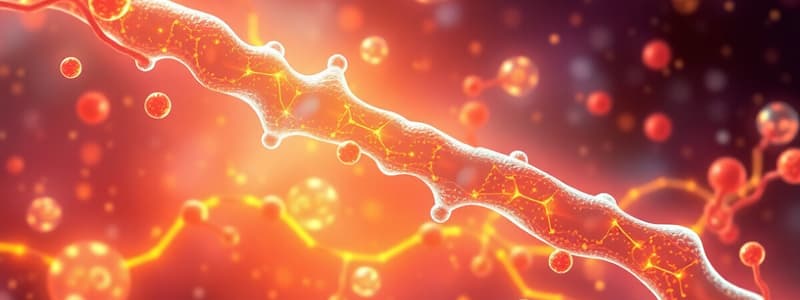Podcast
Questions and Answers
What is the term used to refer to the course's identifier?
What is the term used to refer to the course's identifier?
- Course Subject
- Course Title
- Course Description
- Course Code (correct)
On which date is the information presented relevant to?
On which date is the information presented relevant to?
- 11/30/2024 (correct)
- 12/30/2024
- 11/30/2023
- 10/30/2024
What is the format of the course information provided?
What is the format of the course information provided?
- Tabular Format
- Narrative Description
- Simple List (correct)
- Bullet Points
What does the notation 'اسم ورقم المقرر' represent?
What does the notation 'اسم ورقم المقرر' represent?
What is the significance of the number '2' present in the course information?
What is the significance of the number '2' present in the course information?
What is Dr. Asmaa F. Sharif's highest level of education?
What is Dr. Asmaa F. Sharif's highest level of education?
At which institution is Dr. Asmaa F. Sharif affiliated?
At which institution is Dr. Asmaa F. Sharif affiliated?
Which of the following qualifications is NOT listed for Dr. Asmaa F. Sharif?
Which of the following qualifications is NOT listed for Dr. Asmaa F. Sharif?
What does the acronym MBBCh stand for in Dr. Asmaa F. Sharif's qualifications?
What does the acronym MBBCh stand for in Dr. Asmaa F. Sharif's qualifications?
Which of the following degrees indicates advanced study in a specialized field for Dr. Asmaa F. Sharif?
Which of the following degrees indicates advanced study in a specialized field for Dr. Asmaa F. Sharif?
What is the primary function of the sympathetic nervous system?
What is the primary function of the sympathetic nervous system?
Which neurotransmitter is predominantly released by postganglionic neurons in the sympathetic nervous system?
Which neurotransmitter is predominantly released by postganglionic neurons in the sympathetic nervous system?
What distinguishes the origin of the sympathetic nervous system from the parasympathetic nervous system?
What distinguishes the origin of the sympathetic nervous system from the parasympathetic nervous system?
Which type of receptor is found at the target tissue of the parasympathetic nervous system?
Which type of receptor is found at the target tissue of the parasympathetic nervous system?
During which state does the parasympathetic nervous system primarily operate?
During which state does the parasympathetic nervous system primarily operate?
What is the primary role of the autonomic nervous system?
What is the primary role of the autonomic nervous system?
What physiological change occurs during inhibition in a neuron?
What physiological change occurs during inhibition in a neuron?
What is the result of the degradation of neurotransmitters in the synaptic cleft?
What is the result of the degradation of neurotransmitters in the synaptic cleft?
Which ions are primarily involved in generating an inhibitory postsynaptic potential?
Which ions are primarily involved in generating an inhibitory postsynaptic potential?
What role does acetylcholinesterase play in synaptic transmission?
What role does acetylcholinesterase play in synaptic transmission?
What is NOT a consequence of hyperpolarization in a neuron?
What is NOT a consequence of hyperpolarization in a neuron?
What activity is primarily associated with inhibitory neurotransmission?
What activity is primarily associated with inhibitory neurotransmission?
Flashcards
Course Name
Course Name
A title that identifies the subject matter of a course.
Course Number
Course Number
The unique number assigned to a specific course.
Dr. Asmaa F. Sharif
Dr. Asmaa F. Sharif
A person's name, usually with their academic qualifications.
Ph.D.
Ph.D.
Signup and view all the flashcards
College of Medicine
College of Medicine
Signup and view all the flashcards
11/30/2024
11/30/2024
Signup and view all the flashcards
No.
No.
Signup and view all the flashcards
Somatic Nervous System
Somatic Nervous System
Signup and view all the flashcards
Autonomic Nervous System
Autonomic Nervous System
Signup and view all the flashcards
Sympathetic Nervous System
Sympathetic Nervous System
Signup and view all the flashcards
Parasympathetic Nervous System
Parasympathetic Nervous System
Signup and view all the flashcards
Acetylcholine (Ach)
Acetylcholine (Ach)
Signup and view all the flashcards
Norepinephrine (NE)
Norepinephrine (NE)
Signup and view all the flashcards
Inhibition
Inhibition
Signup and view all the flashcards
Hyperpolarization
Hyperpolarization
Signup and view all the flashcards
Cl- influx
Cl- influx
Signup and view all the flashcards
K+ efflux
K+ efflux
Signup and view all the flashcards
Inhibitory postsynaptic potential (IPSP)
Inhibitory postsynaptic potential (IPSP)
Signup and view all the flashcards
Neurotransmitter degradation
Neurotransmitter degradation
Signup and view all the flashcards
Study Notes
Direct Cholinergic Drugs
- Direct cholinergic drugs mimic the effects of acetylcholine by binding directly to cholinergic receptors (muscarinic or nicotinic).
- These drugs are classified into two groups: direct-acting muscarinic and direct-acting nicotinic.
- Examples of direct-acting muscarinic drugs include acetylcholine, carbachol, and pilocarpine.
- Examples of direct-acting nicotinic drugs include acetylcholine and nicotine.
Cholinergic Receptors
-
Cholinergic receptors are divided into two main types: muscarinic and nicotinic.
-
Muscarinic receptors are G protein-coupled receptors. Subtypes M1, M3, and M5 are excitatory; M2 and M4 are inhibitory. They are located in all target organs innervated by parasympathetic fibers, such as the heart, cardiovascular system, eyes, and bladder.
-
Nicotinic receptors are ion channel-linked receptors and are located at the neuromuscular junctions of skeletal muscle (Nm), adrenal medulla (Nn), CNS (Nn), and autonomic ganglia (Nn).
-
Muscarinic actions vary by receptor subtype and include effects on the eye (contraction of pupil, etc.), heart (bradycardia), endothelium (vasodilation via NO), lungs (bronchial constriction), GIT (increased motility & secretion), urinary bladder (relaxation of sphincters), and exocrine glands (increase secretions).
Cholinergic Agonists (Parasympathomimetics)
- These mimic the actions of acetylcholine.
- Cholinergic agonists are subdivided into direct-acting and indirect-acting.
- Direct-acting agonists bind directly to cholinergic receptors.
- Indirect-acting agonists inhibit the degradation of acetylcholine by acetylcholinesterase.
- Examples of direct-acting include acetylcholine, bethanechol, and pilocarpine.
- Examples of indirect-acting include physostigmine, and neostigmine.
Synthetic Choline Esters
- These drugs include carbachol and bethanechol.
- They are quaternary ammonium compounds.
- They are not orally absorbed and have poor distribution.
- They cannot cross the blood-brain barrier.
- They are not metabolized by cholinesterase.
- They have a longer duration of action compared to acetylcholine.
- They are administered subcutaneously, not intravenously or intramuscularly.
- Carbachol exhibits both muscarinic and nicotinic actions. It's used in glaucoma treatment via eye drops, and rarely for urinary retention or paralytic ileus. Adverse effects include stimulation of norepinephrine (NE) release from the adrenal medulla.
- Bethanechol is used for atonic bladder, postpartum urinary retention, and paralytic ileus. Adverse effects include general cholinergic stimulation—sweating, salivation, abdominal pain—and decreased blood pressure.
Pilocarpine
- A tertiary amine cholinergic agonist.
- Well-absorbed orally and crosses the blood-brain barrier.
- It's primarily used in ophthalmology (treating glaucoma—eye drops) and for xerostomia (dry mouth).
- Pilocarpine is a muscarinic agonist and has a longer duration of action. Adverse effects when given orally include blurred vision, sweating, salivation, diarrhea, and bronchospasm.
Cevimeline
- A direct-acting muscarinic agonist.
- Used for the treatment of dry mouth associated with Sjogren's syndrome.
Nicotine
-
Available as gum, lozenges, inhalers, or patches.
-
An agonist at both Nn and Nm cholinergic receptors.
-
Clinical use: smoking cessation.
-
Common adverse effects: GI issues (nausea and vomiting), diarrhea.
Neurotransmission at Cholinergic Neurons
- Cholinergic neurons involve six sequential steps: synthesis, storage, release, binding to a receptor, postsynaptic response, degradation, and recycling.
- Post-synaptic responses can include excitation (depolarization: Na+ influx) or inhibition (hyperpolarization: Cl- influx & K+ efflux). Acetylcholinesterase degrades acetylcholine in the synaptic cleft, and choline is recycled.
Studying That Suits You
Use AI to generate personalized quizzes and flashcards to suit your learning preferences.





